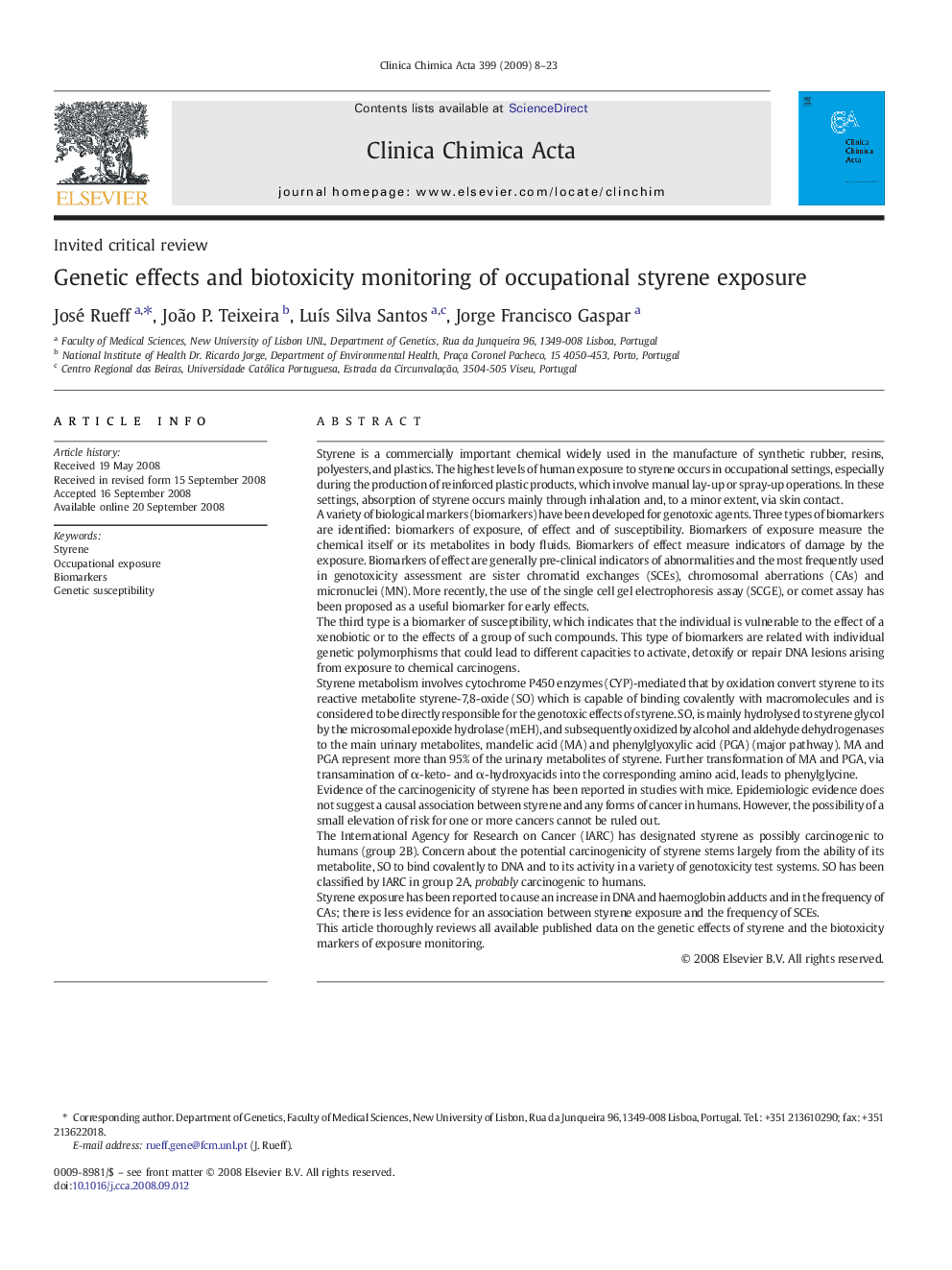| کد مقاله | کد نشریه | سال انتشار | مقاله انگلیسی | نسخه تمام متن |
|---|---|---|---|---|
| 1966804 | 1538731 | 2009 | 16 صفحه PDF | دانلود رایگان |

Styrene is a commercially important chemical widely used in the manufacture of synthetic rubber, resins, polyesters, and plastics. The highest levels of human exposure to styrene occurs in occupational settings, especially during the production of reinforced plastic products, which involve manual lay-up or spray-up operations. In these settings, absorption of styrene occurs mainly through inhalation and, to a minor extent, via skin contact.A variety of biological markers (biomarkers) have been developed for genotoxic agents. Three types of biomarkers are identified: biomarkers of exposure, of effect and of susceptibility. Biomarkers of exposure measure the chemical itself or its metabolites in body fluids. Biomarkers of effect measure indicators of damage by the exposure. Biomarkers of effect are generally pre-clinical indicators of abnormalities and the most frequently used in genotoxicity assessment are sister chromatid exchanges (SCEs), chromosomal aberrations (CAs) and micronuclei (MN). More recently, the use of the single cell gel electrophoresis assay (SCGE), or comet assay has been proposed as a useful biomarker for early effects.The third type is a biomarker of susceptibility, which indicates that the individual is vulnerable to the effect of a xenobiotic or to the effects of a group of such compounds. This type of biomarkers are related with individual genetic polymorphisms that could lead to different capacities to activate, detoxify or repair DNA lesions arising from exposure to chemical carcinogens.Styrene metabolism involves cytochrome P450 enzymes (CYP)-mediated that by oxidation convert styrene to its reactive metabolite styrene-7,8-oxide (SO) which is capable of binding covalently with macromolecules and is considered to be directly responsible for the genotoxic effects of styrene. SO, is mainly hydrolysed to styrene glycol by the microsomal epoxide hydrolase (mEH), and subsequently oxidized by alcohol and aldehyde dehydrogenases to the main urinary metabolites, mandelic acid (MA) and phenylglyoxylic acid (PGA) (major pathway). MA and PGA represent more than 95% of the urinary metabolites of styrene. Further transformation of MA and PGA, via transamination of α-keto- and α-hydroxyacids into the corresponding amino acid, leads to phenylglycine.Evidence of the carcinogenicity of styrene has been reported in studies with mice. Epidemiologic evidence does not suggest a causal association between styrene and any forms of cancer in humans. However, the possibility of a small elevation of risk for one or more cancers cannot be ruled out.The International Agency for Research on Cancer (IARC) has designated styrene as possibly carcinogenic to humans (group 2B). Concern about the potential carcinogenicity of styrene stems largely from the ability of its metabolite, SO to bind covalently to DNA and to its activity in a variety of genotoxicity test systems. SO has been classified by IARC in group 2A, probably carcinogenic to humans.Styrene exposure has been reported to cause an increase in DNA and haemoglobin adducts and in the frequency of CAs; there is less evidence for an association between styrene exposure and the frequency of SCEs.This article thoroughly reviews all available published data on the genetic effects of styrene and the biotoxicity markers of exposure monitoring.
Journal: Clinica Chimica Acta - Volume 399, Issues 1–2, January 2009, Pages 8–23